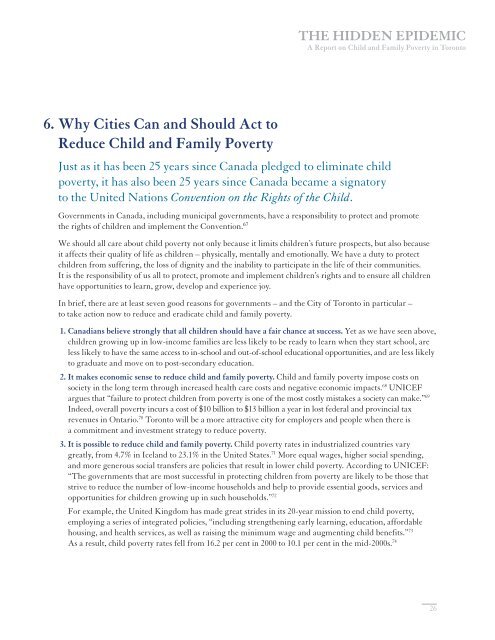The Hidden Epidemic (A Report On Child & Family Poverty In Toronto)
You also want an ePaper? Increase the reach of your titles
YUMPU automatically turns print PDFs into web optimized ePapers that Google loves.
<strong>The</strong> <strong>Hidden</strong> <strong>Epidemic</strong><br />
A <strong>Report</strong> on <strong>Child</strong> and <strong>Family</strong> <strong>Poverty</strong> in <strong>Toronto</strong><br />
6. Why cities can and Should Act to<br />
Reduce child and <strong>Family</strong> poverty<br />
Just as it has been 25 years since Canada pledged to eliminate child <br />
poverty, it has also been 25 years since Canada became a signatory <br />
to the United Nations Convention on the Rights of the <strong>Child</strong>. <br />
Governments in Canada, including municipal governments, have a responsibility to protect and promote<br />
the rights of children and implement the Convention. 67<br />
We should all care about child poverty not only because it limits children’s future prospects, but also because<br />
it affects their quality of life as children – physically, mentally and emotionally. We have a duty to protect<br />
children from suffering, the loss of dignity and the inability to participate in the life of their communities.<br />
It is the responsibility of us all to protect, promote and implement children’s rights and to ensure all children<br />
have opportunities to learn, grow, develop and experience joy.<br />
<strong>In</strong> brief, there are at least seven good reasons for governments – and the City of <strong>Toronto</strong> in particular –<br />
to take action now to reduce and eradicate child and family poverty.<br />
1. canadians believe strongly that all children should have a fair chance at success. Yet as we have seen above,<br />
children growing up in low-income families are less likely to be ready to learn when they start school, are<br />
less likely to have the same access to in-school and out-of-school educational opportunities, and are less likely<br />
to graduate and move on to post-secondary education.<br />
2. it makes economic sense to reduce child and family poverty. <strong>Child</strong> and family poverty impose costs on<br />
society in the long term through increased health care costs and negative economic impacts. 68 UNICEF<br />
argues that “failure to protect children from poverty is one of the most costly mistakes a society can make.” 69<br />
<strong>In</strong>deed, overall poverty incurs a cost of $10 billion to $13 billion a year in lost federal and provincial tax<br />
revenues in <strong>On</strong>tario. 70 <strong>Toronto</strong> will be a more attractive city for employers and people when there is<br />
a commitment and investment strategy to reduce poverty.<br />
3. it is possible to reduce child and family poverty. <strong>Child</strong> poverty rates in industrialized countries vary<br />
greatly, from 4.7% in Iceland to 23.1% in the United States. 71 More equal wages, higher social spending,<br />
and more generous social transfers are policies that result in lower child poverty. According to UNICEF:<br />
“<strong>The</strong> governments that are most successful in protecting children from poverty are likely to be those that<br />
strive to reduce the number of low-income households and help to provide essential goods, services and<br />
opportunities for children growing up in such households.” 72<br />
For example, the United Kingdom has made great strides in its 20-year mission to end child poverty,<br />
employing a series of integrated policies, “including strengthening early learning, education, affordable<br />
housing, and health services, as well as raising the minimum wage and augmenting child benefits.” 73<br />
As a result, child poverty rates fell from 16.2 per cent in 2000 to 10.1 per cent in the mid-2000s. 74<br />
26

















